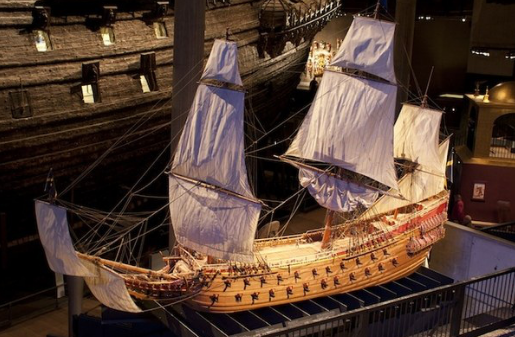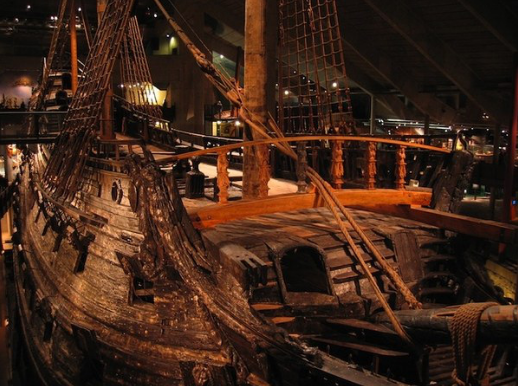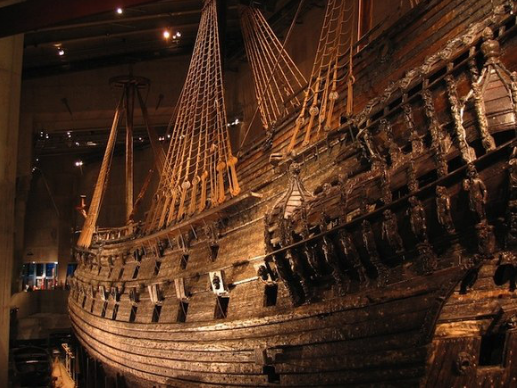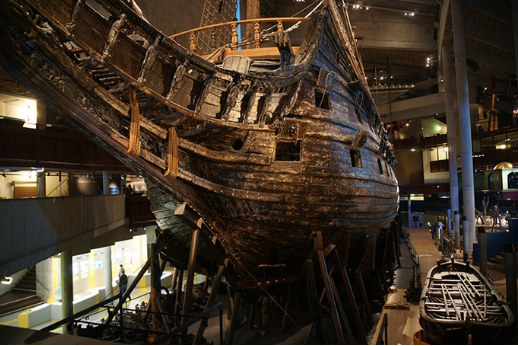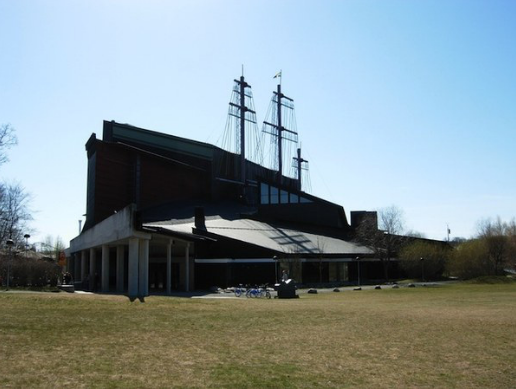The Swedish warship Vasa. It sank in 1628 less than a mile into its maiden voyage and was recovered from the sea floor after 333 years almost completely intact. Now housed at the Vasa Museum in Stockholm, is the world’s best-preserved 17th-century ship.
When departing Stockholm Bay at 4 pm on August 10, 1628, Vasa was the number one high-tech warship in the world. Built by order of King Gustav II Adolf, the Vasa is 68 meters long and carries 64 cannons – an unprecedented number.
A wind, unimaginable tragedy
According to the BBC, the Vasa was one of the first warships to have two decks full of guns. There are also wooden carvings on board that tell many stories about the Swedish royal family.
However, the glorious moment of this “terrible” and beautiful ship was short-lived. Just 20 minutes into her maiden voyage, Vasa sank under the terrified gazes of the mourning crowd, not only killing 30 people on board (other sources say 53) but also turning it into a one of the most terrible and mysterious failures in maritime history.
When the ship had just sailed about 2 knots, a gust of wind picked up, the ship tilted to one side and water began to pour in through the open gun emplacements. Just like that, the ship sank to the bottom of the bay. As for the wind, there are many variations. While the BBC calls it a “strong wind”, the maritime site SimScale describes it as a “light wind”, which only requires one person to steer the ship by hand.
The captain survived the tragedy but was immediately jailed for incompetence. However, a formal trial in September of the same year dropped the charges and released the captain and crew. The exact reason for this change has not been disclosed.
Vasa lay at the bottom of the bay for more than three centuries until 1956, when it was found by Swedish marine technician Anders Franzen. The ship was salvaged from 1959-1961. Later, a separate museum was built to display the ruins of the once-expensive warship Vasa from 1990. This museum even became the most visited museum in the whole of Scandinavia, with over 1 million visitors/year.
Almost 400 years, not sure the answer
After the ship sank suddenly, most of the opinions agreed that it was unbalanced, but why it was unbalanced is a conundrum that challenges experts to this day. According to the BBC, some historians believe that Vasa’s design is problematic, while others speculate that the reason lies in the distribution of the number of cannons – which are already too numerous and weigh nearly 300 kg in total – not. exactly.
The SimScale site is looking for answers through history. On January 16, 1625, King Gustav II Adolf ordered Admiral Fleming to sign a contract with the Stockholm shipyard to build four new ships.
According to the plan, two small ships (33 m long) and two larger ships (about 41 m long) are built within 4 years. However, within the next few months, King Gustav changed his mind several times, leaving the shipbuilders completely confused and confused.
By September 1625, the Swedish navy lost 10 ships, causing the king to order to speed up the construction of 2 small ships. It is also difficult to blame the king because at that time, a large fleet was synonymous with national strength while Sweden had become a major power in Europe and controlled much of the Baltic region.
While the 33-meter-long ship with guns on one deck was being built, the king received word that neighboring Denmark was building a ship with two gun decks. Inevitably, Admiral Fleming received orders to immediately build a 41-meter-long ship with cannons on both the fore and aft decks – something no one had done in Sweden before. The period from 1600-1700 marked an important step forward in the field of naval design, gradually transitioning from 1 gun deck to 2 gun decks.
So from a traditional design, Vasa became the first ship to try a major change. Henrik Hybertsson is a master shipbuilder and owner of Stockholm, but in the face of new circumstances and time pressure, he did not have time to delve into a larger, more complex version of Vasa, but simply “increased the scale. ” to turn the original 33 m Vasa into a 68 m Vasa with 2 gun decks.
As a result, the width of the upper part of the Vasa is much larger than the bottom, pulling the ship’s center of gravity much higher than it was originally designed, SimScale explains. Moreover, the changes are always not carefully documented, there are no specific annotations and there are up to 5 different groups building the hull without any internal communication.
Tragedy continued to take shape without anyone noticing, especially after Mr. Hybertsson fell ill and died in 1627, less than a year before Vasa’s debut.
Vasa is being worn down and tilted towards the museum floor. Photo: Flickr
“Dead” again?
When fully salvaged exactly 333 years after the tragedy, the Vasa is almost perfectly preserved – about 98% of the ship’s wood remains intact. The dark bay bottom has no sunlight, the cold, oxygen-deprived waters slow down spoilage, while the highly polluted waters of the seventeenth century prevent bacteria and “shipworms” (a type of parasite). infamous wood-eating parasite) destroys Vasa.
Since 2000, however, signs of damage have begun to surface on the Vasa as “the best-preserved ship of the seventeenth century” rests in its own museum.
A new study last July – published on the site Biomacromolecules – shows that Vasa degrades slowly and cannot be stopped. The wooden hull of the ship was significantly weakened, partly because the wood used to build the Vasa was 40% weaker than regular oak and susceptible to acidification.
In 2004, the museum upgraded its air control system to ensure stable indoor humidity. Experts are also trying to replace the iron bolts – added to hold the ship in the 1960s but have now corroded – with stainless steel bolts, according to The Wired.
They agree that the Vasa is not immediately collapsing, but that the ship is being eroded by several millimeters every year. Like fate nearly 4 centuries ago, Vasa leaned to one side, towards the museum floor.
Although not wanting to let the Swedish people’s favorite “die” again, the above research team was forced to admit: “It’s too late”. Study co-author, mechanical engineer Ingela Bjurhager of Uppsala University (Sweden), said her team is now focused on designing a new supporting structure to help Vasa maintain its shape.
Hits: 0
